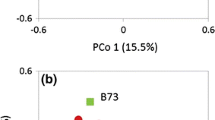Summary
We evaluated cold-tolerance responses of 144 plant introductions (PI) of maize (Zea mays L.), attempting to include in our sample at least one PI adapted to each of the countries or ecological zones respresented in the maize germplasm collection at the North Central Regional Plant Introduction Station at Ames, Iowa, USA. Plant introductions were grown for 42 days in plastic boxes (26 cm long × 19 cm wide × 10 cm deep) in a growth chamber maintained at 10±1 °C. Cold-tolerance responses of each PI were evaluated by three traits: 1) percentage emergence (recorded 30 days after planting), 2) emergence index, an estimate of rate of emergence, and 3) seedling dry weight (sampled 42 days after planting). Estimates of variances and heritabilities for these three traits were large, suggesting that genotypic variation for cold tolerance in the maize germplasm collection would be sufficient to permit selection advance. Furthermore, genotypic correlations among the three traits were high: therefore, improvement by index selection should be possible. Correlations between the cold-tolerance traits and days from planting to 50% silk emergence (an estimate of maturity obtained at Ames. Iowa, USA) were low. Days from planting to 50% silking emergence for the 25 most cold-tolerant PI's ranged from 46 for PI 214279 from Canada to 106 for PI 331440 from Ethiopia. It should be possible, therefore, to develop cold-tolerant genotypes adapted to all latitudes.
Similar content being viewed by others
References
Grogan, C. O., 1970. Genetic variability in maize for germination and seedling growth at low temperatures. Proc. A. Corn Sorghum Res. Conf. 25: 90–98.
Helgason, S. B., 1953. A study of genetic factors and techniques affecting cold-test performance in corn. Ph. D. Thesis Univ. Minn. 92pp. (Library Cong. Card No. Mic. A53-778) Univ. Micro-films, Ann Arbor, Mich., USA. (Diss. Abstr. 13: 461)
Hooker, A. L. & J. G. Dickson, 1952. Resistance to Pythium manifest by excised corn embryos at low temperatures. Agron. J. 44: 443–447.
Mock, J. J. & A. A. Bakri, 1976. Recurrent selection for cold tolerance in maize. Crop Sci. 16: 230–233.
Mock, J. J. & S. A. Eberhart, 1972. Cold tolerance in adapted maize populations. Crop Sci. 12: 466–469.
Smith, P. E. & A. H. Millett, 1964. Germinating and sprouting responses of the tomato at low temperatures. J. Am. Soc. hort. Sci. 84: 480–484.
Tatum, L. A. & M. S. Zuber, 1943. Germination of maize under adverse conditions. J. Am. Soc. Agron. 35: 48–59.
Author information
Authors and Affiliations
Additional information
Contribution from the Iowa Agriculture and Home Economics Experiment Station, Ames, Iowa 50011, and the Agricultural Research Service, U.S. Department of Agriculture, cooperating. Journal Paper No. J-8780 of the Iowa Agriculture and Home Economics Experiment Station, Ames, Iowa. Projects No. 1018 and 2152
Rights and permissions
About this article
Cite this article
Mock, J.J., Skrdla, W.H. Evaluation of maize plant introductions for cold tolerance. Euphytica 27, 27–32 (1978). https://doi.org/10.1007/BF00039116
Received:
Issue Date:
DOI: https://doi.org/10.1007/BF00039116




